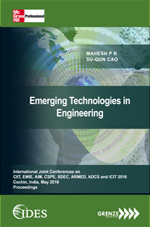Introduction to Energy Efficient Motors
Conference: Fifth International Conference on Control System and Power Electronics
AbstractSelection, Design, Manufacturing, Testing and Installation of Motor is becoming critical day by day because of huge capital cost and energy saving potential involved into it. Motors manufactured prior to 1975 were designed and constructed to meet minimum performance levels as a trade-off for a lower purchase price. Efficiency was maintained only at levels high enough to meet the temperature rise restrictions of the particular motor. In 1977, National Electrical Manufacturers Association (NEMA) recommended a procedure for labeling standard three-phase motors with an average nominal efficiency. Motor efficiency depends on mechanical and electrical imperfections of the motor. Study found that Resistance (I2 R) losses in the stator windings and rotor bars can constitute up to a 15 percent loss in efficiency in three-phase motors. Magnetization losses in the stator and rotor cores cause about a 1 percent to 7 percent efficiency loss. Friction losses in the bearings and inefficiency in the cooling fans result in 0.5 percent to 1.5 percent loss in motor efficiency. Friction and magnetization losses are independent of motor load and relate solely to motor size and design. The remaining losses are referred to as stray load losses. To minimize the above losses Energy Efficient Motors of Efficiency Class IE1, IE2 (High), IE3 (Premium), IE4 (Super Premium) have been introduced in the Industry. For an example, a 4 –Pole 375 kW IE3 Energy Efficient Induction Motor shall have 96 percent Nominal Efficiency according to IS 12615:2011. Thus, a motor that is 96 Percent efficient converts 96 percent of the electrical energy input into mechanical energy. The remaining 4 Percent of the electrical energy is dissipated as heat, evidenced by a rise in motor temperature. The higher efficiency is attained by improved motor design and using high quality materials to reduce motor losses. When we consider energy efficient motors, two factors will affect the payback period: power cost and operating hours per year. Where electricity is inexpensive or operating time is low, it may take several years for the savings from installation of high efficiency motors to outweigh the difference in initial cost. On the other hand, where power costs and the operating hours per year are high, it may be possible to replace an existing standard efficiency motor with an energy efficient motor and realize a payback in less than one year. The present trend of Energy Efficient Motors being adopted in Indian Industry and promoted by Policy Makers is really commendable. It shows the trend in terms of huge energy and cost saving drive, which is very much in need of the hour for Indian Economy. |
CSPE - 2016
|
